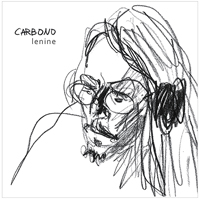
LENINE
CARBONO (Sol Maior)
I spend way too much time hanging out on Facebook, following links to online articles and being amused by my friends' posts and photos. (I guess that's a tribute to the rich lives of my friends.) One of the musicians I follow is Brasilian songwriter Lenine, and recently he announced a live show which would be broadcast on line. He was backed by members of Nação Zumbi (who accompany him on "Cupim de Ferro" on this new album), and the show was superb. Nação Zumbi were the backing band for Chico Science who died tragically but the group overcame the difficulty of losing their leader to carry on (reminiscent of Joy Division's similar metamorphosis), however now in Lenine they've found a great poet to back up. For once the audience was not singing along (they didn't know the songs yet!) and the whole thing went off fabulously. I tried to rewatch it the next day but the link had been deactivated, so it's exciting to now see an album of all-new material from the great man. It's less than 40 minutes but some artists realize you don't need to pad out an album to an hour or 70 minutes just because that's the length of Beethoven's Ninth Symphony. It's mostly three-minute songs which are succinct and change it up frequently. You can listen to his last album, Triz, from 2013 on his web page -- that is how generous he is. And I guess you could wait a couple of years and he will post this one too. The new album is less experimental than Triz and its predecessor Chão, and more straightforward hard driving songs with guitar and drum backing, or ballads with acoustic guitar and slight touches of effects. But there's still room for experiment. The song "À Meia Noite dos Tambores Silenciosos" is basically a poetry recital backed by a full orchestra (Orkestra Rumpilezz) with added horns and five drummers. You can hear a rehearsal here. The poem (translated as "At midnight of the silent drums") is a meditation on the ocean, with Olorum and Saint Joseph invoked in the overwhelming vastness. Another lush arrangement graces "O Universo na Cabeça do Alfinete (The Universe on the head of a pin)," which is another meditation on cosmic matters. This was recorded in Holland with a pick-up orchestra of European musicians. This leads us into a gritty outro called "Undo" with a lot of fuzz tone and thrashing drumkit, two minutes of static so we won't think he is going quietly into the night.

MESTRE CUPIJO E SEU RITMO
SIRIA (Analog Africa)
Another album from Analog Africa signals another direction for the label and another discovery, this time from the Amazonian rainforest. A lot of labels are throwing out Brazilian music to coincide with the World Cup there this summer, but other than the excellent Dona Onete, it has been mostly tired reruns. Not so this energetic mix drawn from Cupijó's six albums. Raised by his musician father to play dance band music that consisted of waltzes, chachas and boleros, young Cupijó was drawn to the black music of Pará. Siriá is a type of music created by the meeting of the Amazon natives with Quilombolas (or maroons), who were runaway African slaves who sought the shelter of the jungle as their refuge. The northeast of Brazil is close enough to the Caribbean to be inundated with the airwaves of Colombia, Dominican Republic and Cuba, and those musical currents are strongly felt in its own music. So, musically Siriá sounds a bit like cumbia and merengue: the recordings have a live energy and are almost frenetic, with the lead instrument being alto sax bouncing off a driving wall of guitar, horns and percussion. It also reminds me of the speedy excitement of Haitian music. Cupijó began to score hits right from the outset with rudimentary recordings captured in dance halls. By his third album he was a huge favorite among party-goers and carnaval attendees and starting from word-of-mouth went on to register massive hits with a string of songs included here.
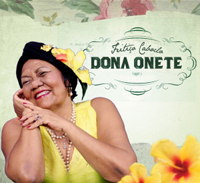
DONA ONETE
FEITICO CABLOCO (Mais Um Discos)
I've been hoping for something Brasilian to come along in time for the World Cup. Four years ago Shakira's remake of Zangalewa's hit "Waka Waka" filled the bill for the South African tournament, and while this is not raucous stamping-out-grassfires samba, it's perfect to get you mildly shimmying. One reason for the mellow restraint is that this is Dona Onete's debut disc, and she is 73. She comes from Pará in the Northeast of Brasil and this album reflects a lifetime of absorption in the sounds of her home. So there is African and European grafted onto the native rhythms as well as noticeable Caribbean pulses in a track like "Jamburana." This has a creeping horn section and a wicked wormy beat like the carousel ride of konpas. Onete began singing at age 11 in unusual circumstances. She was washing clothes on the river bank when she spotted a dolphin. She decided to sing to the dolphin to attract its attention. Next day there were more dolphins and soon she had a regular aquatic audience for her vocalizations. When she grew up she became a professor of History and Amazonian Studies and established folk troupes as part of her curriculum. She established a new musical form, carimbó chamegado, based on traditional rhythms and began composing songs but mainly sang for her own amusement or in bars when pressed to perform. But then some young guys who had a band called Coletivo Radio Cipó heard her sing and wanted her for their band: they had no idea she was an elderly lady. It's melodic and well arranged and a great debut.
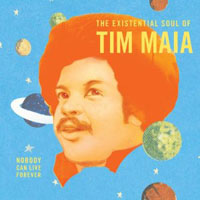
TIM MAIA
NOBODY CAN LIVE FOREVER (Luaka Bop World Psychedelic Classics vol 4)
Reviewed by Lawrence A. Stanley
Tim Maia, who was born and raised in Rio de Janeiro, didn't have a lot of luck in life. He was obese for most of it, struggled with drug use (mainly cocaine) and died young, from a heart attack, at age 55. Even his luck was the product of being unlucky. Already at the age of 14, Maia was making music; when he was 16, in 1958, he formed The Sputniks together with Roberto Carlos, Edson Trindade and others. They landed gigs at dances and on television, but soon disbanded due to differences between Roberto Carlos and Maia. (Carlos went on to mega-stardom singing derivative, deracinated pop music and later, sentimental pap.) Maia's parting with Carlos was probably his first bit of luck. In 1959, at the age of 17, Maia left for Tarrytown, New York, ostensibly to study communications. There he supported himself in low-paying jobs (pizza delivery, dishwasher, short-order cook, janitor), supplemented his income with small-time burglaries and soaked up American R&B: Otis Redding, James Brown, the Four Tops, and so on.
Although Maia formed his own group, The Ideals, he would not see any success with it. On a trip to Florida in 1963, he was arrested for possessing pot while riding in a stolen car and was jailed for half a year, then deported. That was his second bit of luck. Had he not returned to Brazil, he would never have become the beloved star he became almost instantly after recording his first record in 1970. However, the period between 1964 and 1969 wasn't exactly easy. In 1966, Maia was jailed for 10 months in Rio de Janeiro for burglary. (According to the Brazilian writer, José Ruy Gandra, that was Maia's sixth imprisonment, the first four having occurred prior to his move to the United States.)
Between 1966, following his release from jail, and the end of 1969, a few of Maia's songs were recorded by Roberto Carlos, Eduardo Araújo and Maia's childhood friend Erasmo Carlos (no relation to Roberto, but a co-member with Roberto in Jovem Guarda, a pop group created by an advertising agency). Maia also found work as a background vocalist and sometimes producer. But things didn't start to happen until early 1970 when one of his songs, entitled "These are the Songs," was recorded by Elis Regina in duet with Maia, and released on Regina's album, Em Pleno Verão.
On its website, Luaka Bop notes that Maia's first album (called Tim Maia), released in June 1970, "has been called 'a massive cannonball into the pool' of Brasilian culture, the ripples of which are still visible today." This is because the album made soul music a viable Brasilian style by intermixing it -- if not in the same song, then on the same album -- with Brasilian rhythms such as xaxado (pronounced sha-shá-du) and samba. However, with the exception of a single track, The Existential Soul of Tim Maia: Nobody Can Live Forever doesn't draw from either of Maia's first two albums where the cultural mixing is most prevalent. Rather, it centers on the period between 1973 and 1976, when Maia's style had evolved into something that had a lot in common with American funk and R&B, especially the "Philadelphia sound" of Gamble & Huff and the Isley Brothers. There is no mistake in Luaka Bop's choice, but in doing so, the compilation misses at least two Maia classics, "Azul da Cor do Mar (Blue the Color of the Ocean)" and "I Don't Know What To Do With Myself." No matter.
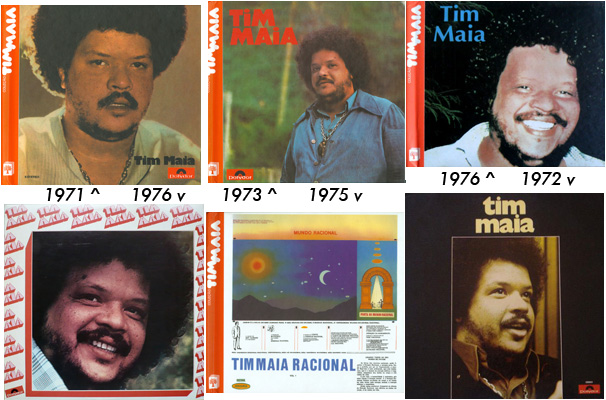
If one begins with Maia's third album, also called Tim Maia, as it happens, there is already too much to choose from. Since most of Maia's albums are entitled Tim Maia, six of the seven albums from which the compilation draws are pictured here (The seventh is Racional vol 2 which has the same cover art as vol one). Of the 11 albums released during the 1970s, only 4 have different titles: Tim Maia Racional, Vol. 1 (1975) and 2 (1976), Tim Maia em Inglês (1976) and Tim Maia Disco Club (1978).
The Luaka Bop compilation is not chronological. It opens up with "Imunização Racional (Que Beleza)" from 1975, but the version here is funkier (and far better) than the one released on Tim Maia Racional, Vol. 1. The alto flute and light funky wah-wah guitar from the album version are replaced by Afrobeat horns and a searing Ernie Isley-like guitar line (think "Who's That Lady"), while congas syncopate the rhythm. The searing guitar can also be heard all over "Bom Senso" (track 10), which was the third track on Tim Maia Racional, Vol. 1. The song, one of Maia's best, features some excellent swooping orchestration that doesn't have the effect so much of "sweetening" the song as making it slightly wierd. "Bom Senso" is only marred (and then just a tiny bit) by Maia's references to the "Cultura Racional" cult, which he joined briefly and to which he dedicated two albums. When Maia exhorts the listener to read "the book," he's not talking about the Bible but a book called Universe in Disenchantment, which claims that the human brain is connected to cosmic energy through the pineal gland. (Yes, another crackpot theory, but probably not any more implausible than religions which don't claim a scientific foundation.) Maia soon caught on that the cult's leader wasn't the pure soul he claimed to be -- he was probably using his penile gland instead of his pineal gland -- and Maia moved on. For years, the Racional albums were unavailable because Maia refused to allow them to be sold. The first volume was re-released in Brasil by Trama in 2006 and both volumes were re-released recently by Abril Coleções. (Maia died in 1998.)
Propaganda for "Rational Culture" also inflicts itself on track 15, entitled "Rational Culture" (also from Tim Maia Racional, Vol. 1), a 12-minute laid-back jam with the risible refrain, "We're gonna rule the world, dontcha know, dontcha know / We're gonna put it together." (The track that precedes it, "You Don't Know What I Know" is a 33-second interstitial piece where Maia exhorts the reader to "read the book." If he could, he would be turning in his grave that this bit was selected for a U.S. compilation.)
But don't get the wrong impression. There is great music here. Three other songs from the Racional period are among Maia's best. Track 3, "O Caminho de Bem" (from Tim Maia Racional, Vol. 2), is Maia at his coolest. The song is an insinuating piece of funk that recalls Stevie Wonder's "Superstition," but with jazzy breaks and a low-key vocal. Track 5, "Quer Queira Quer Não Queira," recalls early 70s Nigerian funk almost as much as it does American funk; while track 7, "Do Leme ao Pontal," is a strutting jam based on a catchy riff. (Although recorded during the Racional period, the song was not actually released until 1986.)
Maia regularly sang in English and Luaka Bop wisely chose a number of those songs -- not because they're in English, but because they're good. Track 2 is the half-sung, half-spoken "Let's Have a Ball Tonight" (from Tim Maia en Ingles, released in 1976, on Seroma, Maia's label named for the leader of Rational Culture and also the word "amores" spelled backward). The music could have been written with the Spinners in mind, but the lyrics are truly peculiar. (Somewhere between singing about politicians trying to achieve peace on earth and "Let's have a ball tonight / it's gonna be like the 4th of July," there's a disconnect.) Tracks 6, 8 and 13 are the three solid pop songs sung in English from Maia's 8th album, Tim Maia, released on Polydor (also 1976): the proto-disco song, "Brother Father Mother Sister;" "Nobody Can Live Forever;" and "The Dance Is Over." These songs, together with "Over Again," from Maia's fourth album, released in 1973, are essential listening for any aficionado of soul music. The compilation also contains two torch songs, "Where Is My Other Half" (1972 - third album) and "Ela Partiu" (released as a single in 1976). The first is a lament in which Maia improvises the vocal line through half the song over a lush soundbed of organ, horns, background vocals, bass and drums, with a bluesy guitar solo floating atop. (It works.) "Ela Partiu" finds Maia more perturbed. The lead vocal ("She left / She never came back") and especially the backing vocals hark back to early 60s gospel-tinged soul, although Maia's repeated cries and the mid-tempo beat gives the song more gravitas than its referents.
In this reviewer's opinion, the only ill-chosen song on the compilation (aside from the 33-second plug for The Universe in Disenchantment) is "I Don't Care," from Maia's second album, released in 1971. Also missing from the compilation are Maia hits such as "Reu Confesso" and "Gostava Tanto de Você (both from the same album as "Over Again.") ("Gostava Tanto de Você" wasn't written by Maia, but by Edson Trindade, perhaps explaining its absence.)
The thing about Maia is that you'll hear many references to American styles -- for example, the Motown, Philadelphia and Memphis sounds, the funk/soul/gospel of groups like the Chi-Lites and Madd Lads, the extended jams of Hamilton Bohannon (who was making his music at the same time as Maia) and Isaac Hayes -- but Maia's music wasn't derivative and he wasn't merely "Brazilifying" American soul, funk and disco. He was making something very much his own.
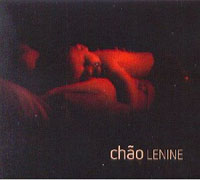
LENINE
CHAO (Universal Music)
A friend sent me a glowing review of Lenine's latest concert in Brasil and I was inspired to check out his latest album, which you can listen to in part, streaming on the artist's website here. Lenine is one of the most brilliant performers working in Brasil today. He writes great songs full of linguistic tricks and intelligence. These aren't the lovelorn lyrics typical to a lot of MPB; his delivery is unexpected and despite his unassuming manner he is a fine showman. Above all his arrangements are orchestrated to make his songs engaging and surprising. "Chão (floor)" starts off with what sounds like someone walking on gravel, but turns out to be a percussion instrument, a kind of guiro with metal ball-bearings wrapped around it, I think. The album abounds with interesting musical effects, heartbeats, lots of birds, and a solid rhythm with, occasionally, real bass and drums, but often as not collaged sounds providing the backing to his provocative lyrics. (The bird is his mother-in-law's pet canary which got into the studio and started singing to the playback, so they decided to include it.) The marching feet on gravel (from the opening) returns again for "Isso é Só o Começo (This is only the beginning)," which is the closer, completing the circle. He is great at building to an ominous intensity, reminiscent of early Pink Floyd, or creating rhythmic drama like late Led Zep! On "Seres estranho (Strange beings)" he heightens the drama quickly with only a few effects and sustains it, then just as quickly cuts to a simple ballad plucked from his Ovation. Suddenly a kettle starts to whistle -- he ignores it, but its insistence creates a differently ominous voice to focus you on the music. He does this again with a chain saw felling a tree on "Envergo mas não quebro (bend but don't break)" which comes next. Much as I hate streaming music, the alternative is a pricy import (Amazon mistakenly has the date as 2007: it came out in 2011), or a download from his website. His site also leads you to videos, including an animation of the title track of Chão, music and lyric sheets, and other stuff.
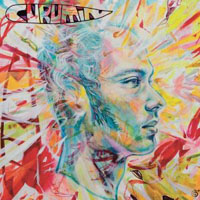
CURUMIN
ARROCHA (Six Degrees 657036 etc)
First off, this is not Arrocha music in the traditional sense -- that, my friend, is wet romantic pap from Northeast Brasil, best left to Zbigniew Podolski, the celebrated ten-foot Pole. This is a mixture of styles, starting with "Afoxoque," a rap-like dirge with insistent synthi bass & random percussive bomps and tinkles, but engaging enough to tweak your interest. Things pick up with a dubby "Treme terra," then go limp again with a wet ballad, "Passarinho," which all things considered, is pretty well arranged & nicely sung. It changes style once more, and just when you're ready to bail out, suddenly there's an echoey slice of Brasilian reggae. It maintains this feel for a spell then goes back to something resembling Kraftwerk on "BlimBlim." Curumin certainly pack in some disparate ideas. But it's worth sticking around for the brief "Acorda" and its heartfelt vocals, this time with a more interesting synth, plus drum and bass and some Space Invader effects for good measure. Some of the tunes are bite-sized which is great for snacking. It's a pleasant light album of contemporary Brasilian pop. With only two years 'til the world cup I predict an upsurge in popularity of Brasilian music. Stay tuned.
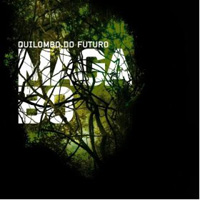
MAGA BO
QUILOMBO DO FUTURO (Post World Industries PWI105)
The "new thing from Brasil" always seems to start in the Northeast, up by the Amazon, and spread south, through Pernambuco to Bahia and thence eventually to O Rio. This is batucada meets electronica, or capoeira meets dubstep. Whatever it is, it has the determination of groups like Chico Science's Naçao Zumbi to break out of a small category (like "Brazil-slash-world" or "exotica") and embrace a wider mix. Maga Bo has worked with Ethio jazzer Mulatu Astatke, Malian techno-whiz Issa Bagayogo, and mixed for Bomba Estereo ("Fuego"), Systema Solar, Spy from Cairo, and Luisa Maita, so he knows the ropes. Or rather which little sliders to push up on the console. "Quilombo," as I recall from the movie, is about resistance. I am glad to say the Afro-Brasilian roots part is more dominant than the drum 'n bass, which I usually equate with slackness. The rhythm tracks are great. Bo (who is an American living in Rio) laid them down with João Hermeto, a real Carioca. Then each track has a different vocal interpretation, from MC Zulu -- a Panamanian now based in Chicago -- to Jahdan Blakkamoore -- a Guyanese dancehall arteest now based in Brooklyn -- to a bunch of emergent Brasilieros, like Mestre Camaleão who sings and plays berimbau. You can check out the first single, "No balanço da canoa (Don't tip the canoe)," on YouTube.
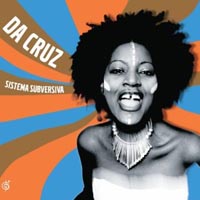
DA CRUZ
SISTEMA SUBVERSIVA (Six Degrees)
This is cooking Brazilian electronica with hints of Axé, Pagodé, Jazz, & the ghost of Bossa Nova. Fronted by vocalist Mariana Da Cruz from Bahia, there's a guitarist and a kicking trap drummer (Pit Lee of Swamp Terrorists, a Swiss garage rock band) and a programmer, Ane H. Guests appear on trumpet, sax and guitars on most tracks, plus percussion was overdubbed in Sao Paolo to beef it up. This is the antidote to all those sleepy, soggy albums called Brazilian Café, or Samba Lounge, or Bossa Beats. It is a refreshing blast of funky frenzy, like a shot of cachaça in your café expresso. (My friend Xico, the cabbie in Bahia, always stopped at a gas station for a "piece of the cat"-- finally I figured out he was referring to their coffee as piss of the cat!) Da Cruz is a good singer but what elevates this album is the fine horn solos. There's a lot of variety but it keeps your feet moving. I foresee it as a great party disc for the summer.

LUISA MAITA
LERO LERO (Cumbancha)
You must be getting soft, you say, when I tell you I like this mellow samba and bossa nova mix from a young Paulista. Luisa Maita has been singing professionally since she was seven. She was named for a song by Antonio Carlos Jobim. I was very apprehensive of this album before I even heard it, because the advance publicity says "her sensual yet soulful voice begs comparisons with everyone from Billie Holiday and Sade to Feist, St. Vincent and Cat Power." OK, PR folk, you may NOT compare anyone to Billie Holiday. Billie Holiday is incomparable. You could say "she is inspired by Billie Holiday," like Darla Hood, but she does not sound anything remotely like Billie Holiday. And to put Shoddy Sadie in the same sentence with Lady Day is offensive. Sade is a one-note wonder: being compared to her is the kiss of death. I have no idea who the other three are, probably Slacker Lounge acts. You have to do better than trot out words like "tropical" or "downtempo." (I guess that's why you sent it to me, to come up with better epithets for you.) When it comes down to it, her voice is pleasant and not as off-key as most Brazilians sound. The production is excellent, with especially crisp percussion & sharp cavaquinho. Then a touch of dubby dub takes you by surprise. Check out the title track here. The touches of electronica are welcome as they create interesting background textures.
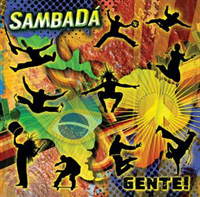
SAMBADA
GENTE! (Sambada)
I once saw a Senegalese dance troupe that consisted of a dozen white American college girls, many of them blonde. Needless to say the Africans in the audience loved it. The dancers were on their way to Senegal to perform and I wondered how they would fare when they performed some traditional dance that was now historically speaking static, and they didn't have the cultural context to innovate. Would they just become a curiosity and fade away? This is a a trend: American groups form around an idea, say Samba or African music or in this case, Pagodé, and play credible covers until they are recognised as an original act in the genre they started out mimicking. There are American, and no doubt European, bands formed around a core of foreign musicians & here is a band from the California college town Santa Cruz with a couple of Portuguese names and then some most-likely Americans filling out the line-up. I put it on thinking I would find it weak, and it was actually really fun. Carnaval just passed by in its annual alcohol-fueled blur in Brasil, and this was a pleasant armchair reminder of the better aspects: loud pumping music & wild swirling dancers (without the crowd of grasping hands in your pockets!). The band has a couple of guests and enough variety to give you a range of sounds, from the Ivete Sangalo sound on "Não Vai embora (Don't go away)" to the big axé groups like Ilê Aiyê, and pagodé ensembles like Ara Ketu on the opening cuts. If you've been to Carnaval in Salvador da Bahia it will be immediately recognisable, if you haven't you will get a thrill from hearing this high-energy music anyway.
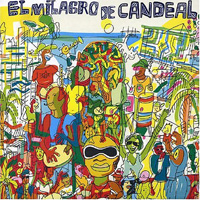
CARLINHOS BROWN ET AL.
EL MILAGRO DE CANDEAL SOUNDTRACK (SONY BMG)
I was going to wait till I had seen the film before reviewing this soundtrack, but it is proving very elusive so here's what I have to say provisionally. You probably checked out the YouTube clip with Marisa Monte and Carlinhos Brown singing to Bebo Valdés' piano accompaniment. Someone even wrote to me saying that they had fallen in love with her! I met her in Salvador but it was during carnaval so only got to say hello, how's things. The film is about Valdés' trip to Salvador da Bahia to check out how the blacks in Brasil fared, compared to the blacks in Cuba, where he is from. The director, Fernando Trueba, also made the brilliant LAGRIMAS NEGRAS. Cuban music is generally loved and respected all over South America so Valdés was lionised and the film is undoubtedly sympathetic and well-crafted. The clip we have seen, of "Musicos" is certainly a delight. There are a few oddities on here, of course, as in any endeavour featuring Carlinhos Brown. We get "Blen, blen, blen" and the axé drums are in full force in the weirdest thing on here, Glenn Miller's "Moonlight Serenade." Timbalada and a bunch of lesser known musicians are also featured.

LENINE (Six Degrees 657036 1127-2)
People are surprised that I spent so much time in Brasil and never got into samba or MPB. I like forro but it doesn't leapt onto the turntable; after the last purge I have about a foot shelf remaining of eclectic Brasilian music: Naçao Zumbi, Batucada, Jackson do Pandeiro, Luiz de Moura Castro. I wish I had the MTV unplugged set by Lenine but, hankering for a fix, got this "best of" anthology from Six Degrees which introduces him to North American ears. Lenine is a good poet with a musical ear, like when he intones "Dolores ... dollares! (Sadness ... dollars)" he gets a lot out of those two words. He plays an acoustic Ovation (I think) which matches the mournful sleepy tone of his voice. As a guitarist, he could be from anywhere, till the berimbau, cuica and subtle electronic effects indicate that odd hybrid of Gilberto Gil & Massive Attack that is the state of the art in Brasil today. His songs are carefully crafted: the entire production, down to the double-tracked harmonies and percussion, seems well thought-out. Coming from Recife in Northeast Brasil, Lenine has written songs for Gil, Sergio Mendes and been covered by Dionne Warwick. The disc opens with "Jack Soul Brasileiro," a tribute to Jackson do Pandiero and closes with "Paciencia," a moving ballad about the speed of life, and spans three of his domestic releases (considerately including English synopses of the lyrics). It should win Lenine legions of new fans in the rest of the New World.
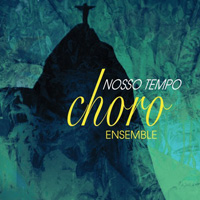
CHORO ENSEMBLE
NOSSO TEMPO (ANZIC 7201)
Choro (pronounced Sho-ho) is an acquired taste. In some ways it's like dixieland or trad jazz, if you don't dig the framework you won't enjoy the music because it has structures and sounds that are particular to it. It's light, but not like samba, and swings, but not like bossa nova. The closest I can come, sorry to say, is "dinner jazz," the kind of music you put on to create a mellow background while you are entertaining. The melodies are wistful, the instrumentation simple: Anat Cohen, the leader, plays clarinet. Pedro Ramos plays cavaquinho, a small mandolin-like tenor guitar, there are 6- and 7-stringed guitars and a percussionist playing pandeiro, a big tambourine.
At 46 minutes the album is long enough to give you an impression of sweetness and not too long to make you want to change it. The repertoire includes some famous Brazilian tunes: a blisteringly tight "Orgulhoso" by Jacob do Bandolim; Pixinguinha's "Ingenuo;" and the highlight of the set, "Brazilieirinho" by Waldir Azevedo, which closes the disc. At some points it reminds me of palm court orchestral music: genteel and almost soporific. "Descendo a ladeira" by Carlos Almeida (one of the guitarists) is speedy and has zabumba, which sounds like metal castanets. On the last cut the cavaquinho leads and the percussionist plays surdo, a booming bass drum, which would have helped liven up some of the other cuts.

CABRUERA
PROIBIDO COCHILAR (Piranha CD PIR1999)
Here's a conundrum: If you go through the Brasilian section in any well-stocked record store in North America you will find a lot of crap. You look in vain for that exciting new band you've heard is tearing it up in Salvador or Sao Paolo. But all you find is generic samey pagode bands, many of them one-hit wonders on their tenth CD, and of course endless dreary samba singers still looking for that lost girl from Ipanema (not realizing she's middle-aged and wrinkled like a walnut). Who's behind it? Why, Universal, Sony and Columbia, of course. So we have to assume they are sure of their market and don't give a toss about the music. Every now and then an independently produced album makes a splash but I have learned that the best Brasilian music is coming out of Germany. (This may change after Brasil knocks Germany out of the world cup in Summer 2006.) Whoever is behind Piranha music has a great ear for what's really vital in Brasilian music. Proof of this is the new Cabruera release: PROIBIDO COCHILAR subtitled "Sambas for Sleepless Nights," which was released by Nikita Music in Brasil in 2004. It's the most interesting thing to come from Brasil in ages. Brasilian rock & progressive pop has languished since the death of Francisco França (Chico Science), though his band Nação Zumbi carries on. Cabruera (their name means a herd of goats, or colloquially, mulattos) are Nordestinos or Pernambuccanos so there's forro & maculele undercurrents in their version of Mangue Beat. The title "No Snoozing" comes from dancehalls of the band's youth where even the accordionist couldn't stop. Fronting the group is Arthur Pessoa on guitar who loves his effects pedals & periodically creates a really eerie effect like a fiddle by rubbing the strings with a ballpoint pen. There are definitely cover versions on here (one song sounds like "You are my sunshine"!), but Cabruera have made it all their own, adding trip hop rhythms to traditional Coco, Embolada and Maracatú. This is a gem of a recording, not to be missed.
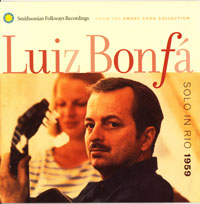
LUIS BONFA
SOLO IN RIO 1959 (Smithsonian Folkways SFW CD 40483)
What better way to cool down the pace than some lovely guitar from Rio? Bonfá is called the co-creator of Bossa Nova. I'm sure many other artists claim to be the other half of that "co" but his credentials are impeccable, as he wrote the lovely "Manhã de Carnaval" featured on the soundtrack to BLACK ORPHEUS. Antonio Carlos Jobim, of course, was a major contender to be the "co", but here it's clear that Bonfá is the virtuoso guitarist. The extra special part of this album is that it was recorded by the great Emory Cook, during his travels, and so the sound is impeccable. The album was released by Cook in 1959 and has long been out of print. Here it is again with an added half hour of previously unknown material from the original session. "A Brazilian in New York," the first of the extra tracks, narrates the story of Bonfá's life in the big apple during the years when he was exposing North Americans to the bossa nova sound. The surreal refrain is "Don't Walk -- Walk!" Born in 1922 Bonfá was classically trained from his early teens and could have become a famous classical guitarist but he devoted himself to Brazilian popular music instead. He rode the bossa boom, recording first on 78s and last on CDs, so his career spanned 40 years. His love of Debussy and deft touch with other modes like calypso and waltz flit in and out of the album. Above all his improvisational skill is stunning. No matter what the context, classical composers or his own well-known Orpheus pieces, he would never play the same way twice, yet there are no wrong moves. And Cook with his battery-run Nagra, which he lugged all over Mexico and the Caribbean before getting to Rio and making this one recording, is in top form as an engineer. There's no fake echo, none of the tinny bathroom sound of 1950s guitar recordings, it's like you are in the room (sitting on a couch by the window, your caipirinha melting away in the glass untouched, looking at clouds behind Sugar Loaf mountain and thinking the distant mountains are like islands and wondering if there are castaways there living on roast fish and coconut). Though many of the additional tracks are fragments or false starts, they are all interesting, even the second takes, as they give you a complete picture of the evening (now Corky the Corcovado Christ has vanished in the clouds & things look natural) with Bonfá at his loosest, most relaxed, and in heavenly form.
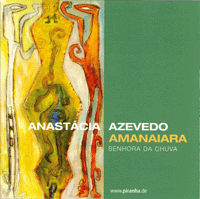
ANASTACIA AZEVEDO
AMANAIARA (Piranha PIR1893)
Piranha strikes again with a great album that goes beyond the formulaic MBP (Musica Brasileira Popular) to a new type of fusion. It is Brasilian with break beats and hints of electronica but is well-crafted with excellent songs by Azevedo and instrumentation by her partner Zé Eugenio. They come from Northeast Brasil, near Fortaleza, but now reside in Berlin. Their art encompasses a lot of traditional styles, not just Samba, but Coco, Xaxado, Forro, Baiao and Xote. The Xaxado, a relentless tune with a backbeat is dedicated to Lampião, legendary Nordestino folk hero and bandit. The subject of many Livros do Cordel (pamphlet ballads), Lampião was the scourge of the local authorities in the 1930s, shooting cops on sight. It's refreshing to find such literate songwriting. This is followed by a change of pace into the title cut (which translated as "Rain" suggested by a tinkling triangle). Subtitled "Senhora da chuva (Lord of Rain)," it was probably prompted by how much wetter it is in Berlin than Fortaleza. There's a reggae-esque groove to this one, and the tempo changes again for "Pé de Côco." Top-rated Brasilian percussionist and bandleader Dudu Tucci appears throughout, keeping the congas prominent and the other players on their toes.
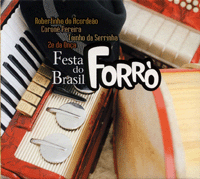
VARIOUS ARTISTS
FESTA DO BRASIL FORRO (Iris Music 3001 879)
Brasilians have a hundred ways of preparing beef and a hundred variations on the Country & Western theme which makes FESTA DO BRASIL FORRO a very interesting compilation. There's no beef but a fair amount of corn: It includes bad oompah music but also some stinging rock guitar. The second half of the album is given over to an accordeon player, the aptly named Robertinho do Acordeão, and it gets kind of cheesy, I should say repetitious and positively polkacidal, but the first nine cuts, by Coroné Pereira and Toinho da Serrinha, are solid. Part one includes a real gem, "E probido cochilar" with a non-stop pulse and acid rock guitar at the outro. There's a cover of "Sebastiana" made famous by Jackson do Pandeiro that is truly catchy. But, like the carne de sol in those roadside Churrascarias, after 40 minutes that's as much as you can stomach at one sitting, and it's time to move on.
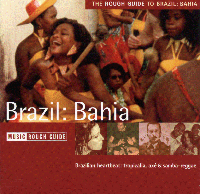
ROUGH GUIDE TO BRAZIL: BAHIA (RGNET 1135 CD)
SAMBA SOUL GROOVE (Universal B0002523-02)
I am ambivalent about this Rough Guide CD. It's typical Bahian music which means a mixed bag, some of it not so great. To visit Bahia is to love it & to love someplace is to forgive its shortcomings. When you are there everyone is beautiful, the music is wonderful, the beggars are charming, the police are... well, let's not exaggerate. I did carnaval three years running in Bahia and spent over 7 months living and working there. I even thought about relocating to the old city of Santo Antonio which is rich with history and still a bit seedy. But there's no real food in Bahia (I am spoiled by the Bay Area with its wonderful array of Asian cuisine, from $2 Vietnamese BBQ sandwiches on french bread to $4 Batore Cholle at VIK's), and any expatriot is immediately lumped into the "expat" camp with the undesirables who have washed up there for whatever reason. The music is vapid and ephemeral. Sure it's incredible to be part of a procession led by 100+ drummers, fired with shots of hard liquor disguised in fruit juice, dancing shirtless in the humid tropical night, but would you want to have it on your stereo back home? At its best Bahian music is rootsy with strong rhythms, inventive melodies and catchy hooks; at its worst it is global pop cannibalising its own history as well as snippets of heavy metal, folk and gospel abandoned by the rest of the world.
I was in a news-stand in Pituba one night wearing my CHESS records t-shirt and a drunk said, loudly, behind my back, "A musica Americana e bosto! (American music is shit!)" But I figured he probably was referring to Madonna or Lynyrd Skynyrd and I heartily agree. People in Brasil don't get to hear the Chess artists, which was the source for the best pop music America ever produced. Brasil's own traditions become diluted though occasionally a great artist like Jackson do Pandeiro, Luiz Gonzago or Naçao Zumbi's Chico Science reasserts a native voice. Every year music is cranked out for carnaval by groups hoping for a shot at the big time, and every year the same suspects, Daniela Mercury, Ara Ketu, Ivete Sangalo, & E O Tchan hog the limelight. There's an annual official CD on Universal called AXÉ BAHIA (the irony is Axé is great drumming music, while this pablum is really Pagodé) and then bootlegs of the better stuff which sometimes make it out as supplements to the local papers on the Saturday after carnaval.
This ROUGH GUIDE is one of those mainstream shots. Too bad they didn't go for the undercurrent which is much more vital and enduring, but it still represents what foreigners are apt to take away from carnaval as part of their memories. It has the heavy wetness factor with two Daniela Mercury cuts & the typical drum sound in two pieces from Timbalada. It does evoke Bahia, and if you start with track 5, "Pitada de tabaco" by Riachão you can get right to the catchiest track on here. There's a wonderful atonal string part (like plucked bicycle spokes) as the hook. This is from a tribute album to the 81-year-old sambista Riachão that really grooves (is that Fred Danto on trombone?). Timbalada deliver a characteristic song, then there's a solid, rootsier piece from Ilê Aiyê, who are consistently one of the most interesting bands in Bahia, from their 2000 album CANTO NEGRO (though it's not credited as such on this CD). Muzenza are up next: though they usually play reggae, this is a forró piece and has a nice underpinning of Afro-brasilian drumming with squeezebox. But too soon we are back to the vapid Daniela Mercury and it's time to change the disc. Four out of sixteen ain't bad but it's no shining example of programming either. Though it's a cover I would have included Braga boys' "Uma Bomba" (because they make it uniquely Bahian with rap and reggae covered too), along with Pagod'Arte's anthemic "Tapa na cara," (It's very sexist but accurately portrays Bahian attitudes) and Harmonia do Samba's killer "Desafio" (live at Okka Bier -- one of the greatest bootleg albums never released), Ara Ketu's "Pipoca," E O Tchan's "Dança do bumbum," Bom Balança's "Tjc bom," Gang do Samba's "Raimunda," As Meninas' "Xibom bombom," and Didá Banda Feminina's "Filhos do Tempo." (Maybe not all, but certainly some of those.) However my compilation has more of a street sensibility and fewer of the samba-like slow tracks you might need for balance. The light touch on the ROUGH GUIDE is represented by Tom Zé and Banda Percucia who make their own instruments; the generic reggae of Bahia is demonstrated by Edson Gomes, while the inevitable hip-hop-reggae-pagodé-forró fusion is provided by Tony Mola and Bragadá.
P.S. SAMBA SOUL GROOVE is another weak disc Deejay IJ was trying to fob off on me. Os Mutantes' "She's my Shoo Shoo" and Jeelberto Jeel's cover of the classic "Chiclete com banana" are the best cuts on here; otherwise it's a mushy mess of sopping samba with a little life shown by Erasmo Carlos but nothing original from the prime exponents: Jorge Ben Jor, Gal Costa, etc.
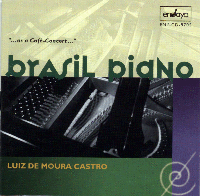
LUIZ DE MOURA CASTRO
BRASIL PIANO (Endayo CD 9705 1997)
I have a tentative connection with the French composer Darius Milhaud in that we both taught at Mills College in Oakland. Like Bartok, who drew from gypsy music or Gershwin who adopted Ernesto Lecuona's songs for his "Cuban Overture," Milhaud adapted Brasilian tunes for his "Saudades do Brasil." Milhaud spent 1918-9 in Rio absorbing the local culture. He admired Ernesto Nazareth, who played accompaniment to silent moves, and Glauco Velasquez, and hung out with composer Henrique Oswald. Oswald's influence on Milhaud can be heard in Milhaud's later works "Scaramouche" and "Le Boeuf sur le toit." At the time Milhaud was secretary to Paul Claudel, the playwright who was French ambassador to Brasil. (Marcel Duchamp was there at the same time!) Oswald and Nazareth are now recognised as important classical composers, as important in their own country as Milhaud in France. When a Brasilian friend played me some Nazareth pieces on his guitar I was entranced and sought out his music. BRASIL PIANO played by Luiz de Moura Castro is a café-concert of delightful and memorable tunes from a century ago, played with verve and passion. Eight composers are represented. Nazareth gets two cuts, and his moving "Odéon" alone is worth the cover charge. Others among the composers came from Europe and were fascinated by the tango and other regional dances. Most of them died tragically early deaths, but that was the common lot in those times. Brasilian musicologists will point out that the Brasilian tango is a relative of the Cuban habanera, and not the Argentine tango. The "low-life" version of this dance became popular as the maxixe, a sound that Nazareth explored in his music, employing typical African drum beats in his compositions. This makes a nice fit with the formality of the European waltzes and polkas found in much classical music of the fin-de-siêcle. Lundi themes from Congo slave dances can be found in Francisco Mignonne's "Congada" -- a piece for four hands, on which the performer is joined by his wife. As Brasil emerged from the colonial period, the music naturally changed with it, but this recording gives a wonderful glimpse into the drawing rooms frequented by Machado de Assis' tragi-comic characters Bras Cubas, Rubião, and the dog-philosopher Quincas Borba. It's gorgeous with occasional touches of Afro-Brasilian "wickedness" -- as those fin-de-siècle Brasilians called it -- creeping in. (I also recommend the Nonesuch album of Milhaud's piano music played by William Bolcom.)